CapLoader 1.6 Released

CapLoader is designed to simplify complex tasks, such as digging through gigabytes of PCAP data looking for traffic that sticks out or shouldn’t be there. Improved usability has therefore been the primary goal, when developing CapLoader 1.6, in order to help our users do their work even more efficiently than before.
Some of the new features in CapLoader 1.6 are:
- Context aware selection and filter suggestions when right-clicking a flow, session or host.
- Support for IPv6 addresses in the BPF syntax for Input Filter as well as Display Filter.
-
Flows that are inactive for more than 60 minutes are considered closed. This timeout is configurable in
Tools > Settings .
Latency Measurements
CapLoader 1.6 also introduces a new column in the Flows tab labeled “Initial_RTT”, which shows the Round Trip Time (RTT) measured during the start of a session. The RTT is defined as “the time it takes for a signal to be sent plus the time it takes for an acknowledgment of that signal to be received”. RTT is often called “ping time” because the ping utility computes the RTT by sending ICMP echo requests and measuring the delay until a reply is received.
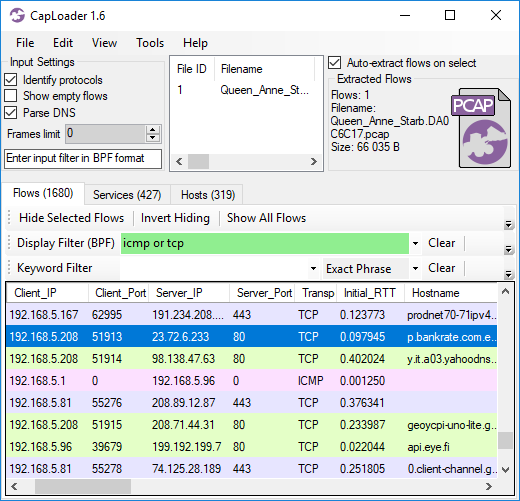
Image: CapLoader 1.6 showing ICMP and TCP round trip times.
But using a PCAP file to measure the RTT between two hosts isn’t as straight forward as one might think. One complicating factor is that the PCAP might be generated by the client, server or by any device in between. If we know that the sniffing point is at the client then things are simple, because we can then use the delta-time between an ICMP echo request and the returning ICMP echo response as RTT. In lack of ping traffic the same thing can be achieved with TCP by measuring the time between a SYN and the returning SYN+ACK packet. However, consider the situation when the sniffer is located somewhere between the client and server. The previously mentioned method would then ignore the latency between the client and sniffer, the delta-time will therefore only show the RTT between the sniffer and the server.
This problem is best solved by calculating the Initial RTT (iRTT) as the delta-time between the SYN packet and the final ACK packet in a TCP three-way handshake, as shown here:
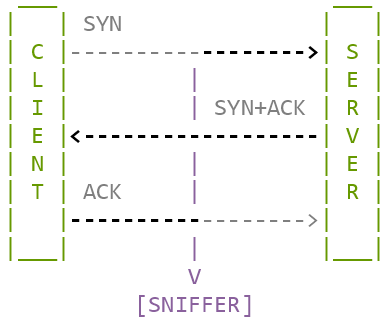
Image: Initial RTT is the total time of the black/bold packet traversal paths.
Jasper Bongertz does a great job of explaining why and how to use the iRTT in his blog post “Determining TCP Initial Round Trip Time”, so I will not cover it in any more detail here. However, keep in mind that iRTT can only be calculated this way for TCP sessions. CapLoader therefore falls back on measuring the delta time between the first packet in each direction when it comes to transport protocols like UDP and ICMP.
Exclusive Features Not Available in the Free Trail
The new features mentioned so far are all available in the free 30 day CapLoader trial, which can be downloaded from our CapLoader product page (no registration required). But we’ve also added features that are only available in the commercial/professional edition of CapLoader. One such exclusive feature is the matching of hostnames against the Cisco Umbrella top 1 million domain list. CapLoader already had a feature for matching domain names against the Alexa top 1 million list, so the addition of the Umbrella list might seem redundant. But it’s actually not, the two lists are compiled using different data sources and therefore complement each other (see our blog post “Domain Whitelist Benchmark: Alexa vs Umbrella” for more details). Also, the Umbrella list contains subdomains (such as www.google.com, safebrowsing.google.com and accounts.google.com) while the Alexa list only contains main domains (like “google.com”). CapLoader can therefore do more fine-granular domain matching with the Umbrella list (requiring a full match of the Umbrella domain), while the Alexa list enables a more rough “catch ‘em all” approach (allowing *.google.com to be matched).
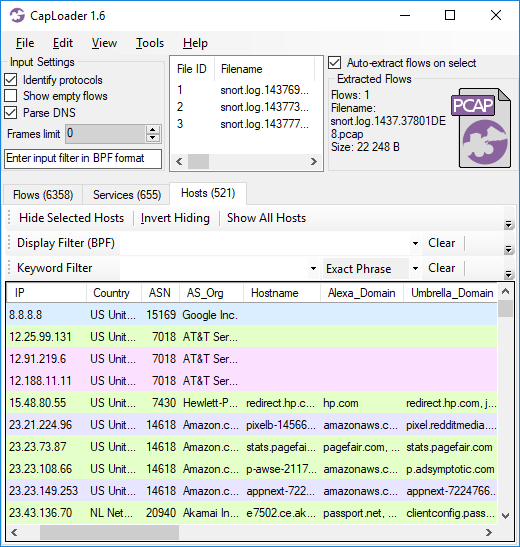
CapLoader 1.6 also comes with an ASN lookup feature, which presents the autonomous system number (ASN) and organization name for IPv4 and IPv6 addresses in a PCAP file (see image above). The ASN data is also used to provide intelligent display filter CIDR suggestions in the context menu that pops up when right-clicking a flow, service or host.
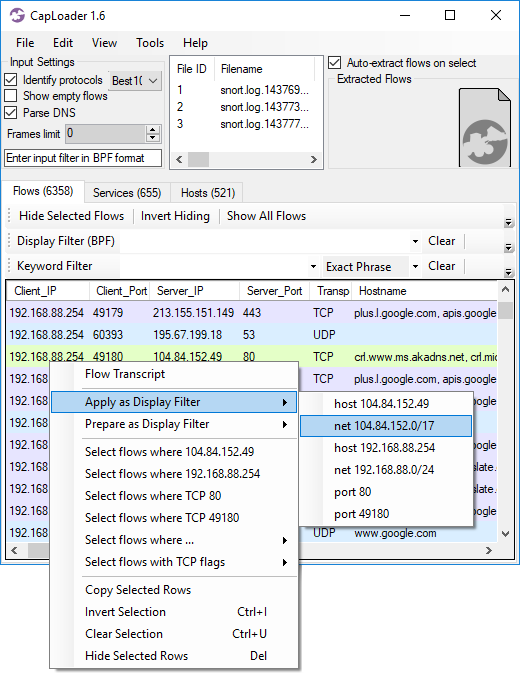
Image: Context menu suggests Display Filter BPF “net 104.84.152.0/17” based on the server IP in the right-clicked flow.
Users who have previously purchased a license for CapLoader can download a free update to version 1.6 from our customer portal.
Credits and T-shirts
We’d like to thank Christian Reusch for suggesting the Initial RTT feature and Daan from the Dutch Ministry of Defence for suggesting the ASN lookup feature. We’d also like to thank David Billa, Ran Tohar Braun and Stephen Bell for discovering and reporting bugs in CapLoader which now have been fixed. These three guys have received a “PCAP or it didn’t happen” t-shirt as promised in our Bug Bounty Program.
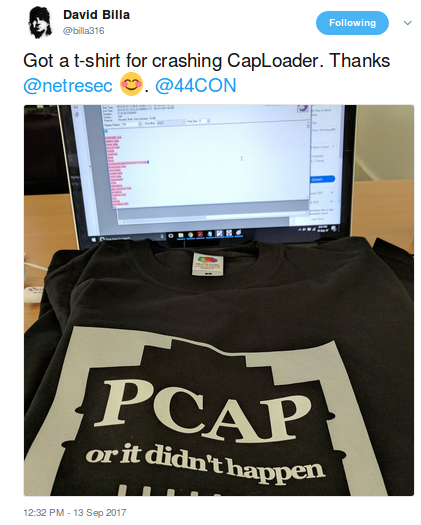
If you too wanna express your view of outlandish cyber attack claims without evidence, then please feel free to send us your bug reports and get rewarded with a “PCAP or it didn’t happen” t-shirt!
Posted by Erik Hjelmvik on Monday, 09 October 2017 08:12:00 (UTC/GMT)
Tags: #CapLoader #free #IPv6 #BPF #CIDR #PCAP #Umbrella #Alexa



